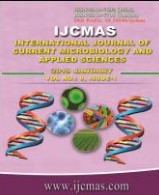


 National Academy of Agricultural Sciences (NAAS)
National Academy of Agricultural Sciences (NAAS)

|
PRINT ISSN : 2319-7692
Online ISSN : 2319-7706 Issues : 12 per year Publisher : Excellent Publishers Email : editorijcmas@gmail.com / submit@ijcmas.com Editor-in-chief: Dr.M.Prakash Index Copernicus ICV 2018: 95.39 NAAS RATING 2020: 5.38 |
Epilepsy is one of the most common and important neurological disorders among children especially in developing countries. Toxoplasma gondii (T. gondii) is an intracellular protozoan capable of forming cysts in the brain of chronically infected humans. Moreover, the larvae of Toxocara canis (T. canis) can locate in the central nervous system leading to several neurological disorders. This study was undertaken to identify the prevalence and risk factors of toxocariasis and toxoplasmosis in children with idiopathic epilepsy. This study was conducted on 150 children aged 2−15 years, including 100 children suffering from idiopathic epilepsy and 50 apparently healthy children as a control group. All children were submitted to clinical questionnaire. They were tested for the presence of anti-Toxocara IgG by ELISA and western blotting, and for presence of anti-Toxoplasma IgG and IgM by ELISA and avidity test. The frequency of Toxocara infection in epileptic patients was 13% versus 4% of the healthy group by ELISA. By western blotting technique, Anti-Toxocara IgG antibodies were detected in 7 (53.8%) of ELISA positive children in epileptic children group, whereas the serum samples of all ELISA-positive normal children were negative. Contact with dogs is the main risk factors for toxocariasis. Regarding T. gondii, by ELISA, 74 (74%) epileptic children had anti-T. gondii antibody, 59 had Toxoplasma IgG only, 3 cases had Toxoplasma IgM only, and 12 cases had both Toxoplasma IgG and IgM. Moreover, 20 (40%) normal children had positive results. Residence, contact with cats, contact with soil, and drinking unfiltered water are important risk factors for toxoplasmosis. There was significant association between toxoplasmosis and idiopathic epilepsy. Despite being statistically insignificant, the association between Toxocara infection and epilepsy still needs further investigation.
 |
 |
 |
 |
 |